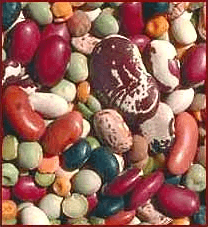Protein for Older Adults

By Reed Mangels, PhD, RD
A Vegetarian Resource Group member wrote to us with concerns about getting enough protein because they weren’t able to tolerate more than half a cup of beans a day. They had heard that older adults need more protein.
There is reliable research that suggests that older adults need slightly more protein than younger adults do. A somewhat higher protein intake, especially when combined with resistance training can build muscle in older adults. This increased muscle can help to offset the muscle loss that is a part of the aging process. Muscle loss can increase the risk of falls and keep older people from doing the tasks they’d like to do.
How much more protein are we suggesting? Get out your calculator! It seems like between 0.36 and 0.57 grams of protein per pound of body weight along with resistance training can lead to a larger muscle mass in older people (1). In practical terms, if you weigh 120 pounds, these recommendations would suggest that you get 43 to 68 grams of protein a day; for someone weighing 150 pounds the recommendations suggest 54 to 86 grams of protein. You can use this helpful table to see how much protein is in many vegan foods (scroll down to table 2).
Some experts (2,3) suggest that spreading out protein over the entire day, instead of eating one or two higher protein meals may further support muscle building. So, for example, if you calculated that you needed 86 grams of protein per day, you might try to eat around 30 grams of protein at each of 3 meals.
Here are some sample meals that have around 30 grams of protein and don’t rely heavily on beans since the person who originally asked the question didn’t want bean-heavy meals.
- A toasted bagel with 2 Tablespoons of soy nut butter with 8 ounces of pea protein milk and a banana
- Strawberry Smoothie made with 8 ounces of oat milk, 2 scoops of rice protein powder, a Tablespoon of nut butter, and ½ cup of strawberries
- Scrambled tofu with toast: 6 ounces of extra firm tofu scrambled with half a cup each of onions and peppers, and 2 Tablespoons of nutritional yeast; 2 slices of whole grain toast
- 2 burritos made with ½ cup of cooked lentils, 1 cup of cooked quinoa and 1 cup of steamed chopped broccoli
- Veggie burger on a bun with a cup of sweet potato oven fries, peas and a cup of steamed green peas
- Chili made with ½ cup of prepared TVP and ½ cup of beans served over 1 cup of cooked quinoa; and a corn muffin
- Stir-fry with 3 ounces of sautéed seitan strips, ½ cup each cauliflower and carrots, and 3 Tablespoons of slivered almonds served over 3/4 cup of cooked brown rice
- Tempeh (¾ cup) in barbecue sauce served over a medium baked potato with 1 cup of sautéed collards
- Tofu in peanut sauce (6 ounces of extra-firm tofu and 3 Tablespoons of peanut sauce) mixed with a cup of steamed kale and served over ¾ cup of whole-wheat pasta
Of course, you may need more (or less) protein than in these examples and don’t want to always calculate the protein content of every meal. You can simply try to eat concentrated protein sources such as soy products, seitan, beans, quinoa, nuts, and nut butters throughout the day.
To learn more about nutrition and other issues for older adults see Resources for Seniors
References
1. Haub MD, Wells AM, Tarnopolsky MA, Campbell WW. Effect of protein source on resistive-training-induced changes in body composition and muscle size in older men. Am J Clin Nutr. 2002; 76(3): 511–517.
2. Farsijani S, Morais JA, Payette H, et al. Relation between mealtime distribution of protein intake and lean mass loss in free-living older adults of the NuAge study. Am J Clin Nutr 2016;104:694–703.
3. Farsijani S, Payette H, Morais JA, et al. Even mealtime distribution of protein intake is associated with greater muscle strength, but not with 3-y physical function decline, in freeliving older adults: the Quebec Longitudinal Study on Nutrition as a Determinant of Successful Aging (NuAge study). Am J Clin Nutr 2017; 106:113–24.
